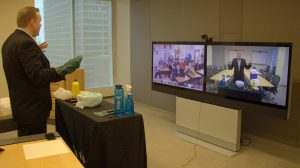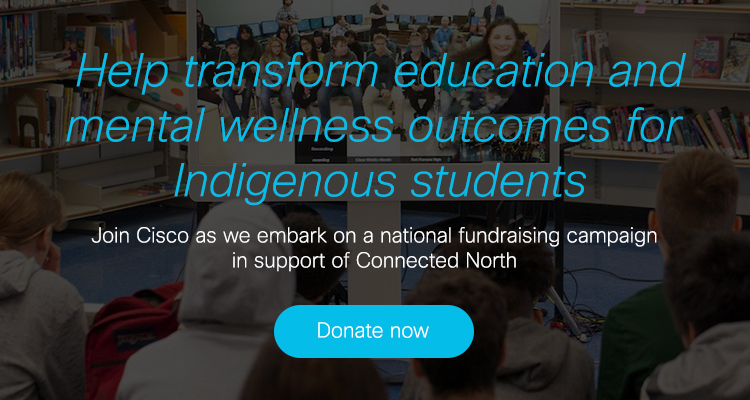
New opportunities, new connections, and new paths to learning and growing through Connected North
5 min read
This post is part of a series highlighting the Stories of Connected North, a transformative program bringing education and mental wellness resources to remote communities.
The first time I visited a remote Northern community I was really struck by two things – first, the lack of resources that we all take for granted in the south. And secondly, the incredible resilience of the people who lived there, overcoming enormous challenges. They deserved access to the same opportunities and experiences available to the children in the south. And yet, because of the reality of the huge distances that separate us, and the unreliable connectivity, they just weren’t available.
We knew at Cisco that we wanted to leverage the incredible capability of our technologies for CSR programs in Canada, and so we spent a year strategizing and doing research on the social issues that we could address through our technology. As part of this we looked at the challenges faced by remote Northern communities. I knew we had an opportunity to apply all the things we do best at Cisco – our amazing technology, our incredible people, our knowledge of the industry, our ecosystem – to unleash impactful change. But we needed to be thoughtful in our approach. We needed to understand the issues through the eyes of the local community. We needed to build real partnerships, built on respect and trust. And so we spent a year meeting people, travelling to the north, learning first-hand about the issues. Listening.

It was during this year that I heard Mary Simon speak. At the time, Mary was the leader of Inuit Tapiriit Kanatami – the association of the Inuit Peoples of Canada. Mary spoke passionately about two critical issues facing her community, the high dropout rate of students in high school, and the tragically high rate of youth suicide – the highest per capita globally. It was absolutely unacceptable.
It was clear that these issues were exacerbated by a lack of adequate resources on the ground – access to more training for teachers, to more preventative mental health and wellness services and a range of other supports that were difficult to access over thousands of miles. Bringing these resources into a community on a regular basis was expensive, and difficult. This, I thought, we could change.
Mary spoke passionately about two critical issues facing her community, the high dropout rate of students in high school, and the tragically high rate of youth suicide – the highest per capita globally. It was absolutely unacceptable.
I’ll never forget Mary’s reaction to her first TelePresence experience [Cisco’s video technology]. We ran a session between Ottawa and Toronto. When she saw the quality of the video interaction and heard our proposal to deliver a range of services, and experiences, to students in communities across Nunavut she said, “We should try anything that will make the classroom more engaging. Anything that makes the classroom more fun, and that encourages kids to come to school, is worth trying. Let’s do it.”
A few months later, after a generous donation of bandwidth from our fabulous service provider partner SSi Micro, we were up and running in Aqsarniit Middle School in Iqaluit. At the time, we simply wanted to connect kids with labs so they could do lab experiments. We were thinking in terms of “what would be useful that they don’t have now?” We had a modest start.
But over the years, as Connected North has grown from one to thirty schools, we’ve learned that so much more is possible. As we introduced Connected North into more schools, as we started to understand the challenges a little bit more, as we got to know these communities, and as they expressed their needs to us, we built out a whole range of virtual services – virtual sessions that could be curated and customized for each school, and in fact, for each student.
“We should try anything that will make the classroom more engaging. Anything that makes the classroom more fun and that encourages kids to come to school is worth trying. Let’s do it.”
So our simple, modest objective – to connect students with a lab – evolved. And it did so in response to what the communities asked of us. Virtual field trips, mentoring, future pathways discussions to introduce children to a range of career options, preventative mental health and wellness, teacher training, cultural exchange with other schools across north and south, and so much more. We’re delivering these services now with a single goal in mind, and that is to strengthen the resilience of these kids. Because we need to level the playing field and give these children the opportunities they deserve. Some of these communities are tackling serious systemic issues around health, housing, poverty. These conditions impact the children that live there. And by listening to the community leaders, we learn what we can do to bring the right services to the right students at the right time.

We cannot solve all the problems. But we can focus on supporting the kids on their learning journeys. Building their self-confidence. Encouraging their natural talent and interests. That is the magic of video collaboration.
I feel huge frustration when I go into these communities and see the reality, and some of the tough challenges our students deal with every day. But I also see tremendous hope and resilience. We are proud of the partnerships with our schools and local leaders – we honour their past, the rich heritage. And we work very hard in these partnerships to infuse all the content, every single Connected North session, with a deep foundation in Indigenous heritage, culture, and Indigenous ways of knowing and learning. Most of our Connected North team members are themselves Indigenous. Our ability to co-create our content, working directly with the schools, makes this program so unique. We are 100 per cent focused on ensuring that our content is culturally sensitive, relevant, and a celebration of heritage and language.
I’ll never forget one of our early sessions that connected an Ojibway school in Northern Ontario with a school in Vancouver. The students in both schools had been given an assignment, to come up with survival strategies in the wilderness. Students in Vancouver painted this huge tree, and their survival tips were written on each “leaf”. They rolled it up and sent it off to the Ontario school. When it arrived, the Ontario students were tasked with finishing the tree. So these students drew the roots. Seven roots for the Seven Grandfather Teachings of wisdom, love, respect, bravery, honesty, humility, and truth. Then one of them was chosen to present these seven grandfather teachings over video to the class in Vancouver, thousands of miles away. As they unfurled the tree, the principal standing beside me started crying. I was immediately concerned and asked her what was wrong.
“It’s just that I’ve never seen the kids present like this. They are so confident and I am so proud of them.”
I knew at that point that we had to keep going – offering this connectivity and this network to other schools. At Cisco, we believe and know that the experiences and the traditions of the Indigenous peoples of Canada informs us all as Canadians. It drives us. And our commitment to this program.
Connected North was founded in this spirit of Reconciliation – to break down the barriers to learning more about one another, to provide support and services otherwise unavailable in remote communities, and to reach children with experiences that inspire them. That starts by zeroing in on each child, understanding what their passion may be, what moves them – what it is that lights them up, what it is that makes them feel valued. And then bringing those experiences directly to them – so they can shine.
We have a young rapper in the Yukon who surprised himself and his community with his amazing rapping and poetry skills after working with a Toronto-based professional over the Connected North network. The principal of the school sent me an incredible note telling me how moved she was to see this young man discover his voice and his passion through new experiences. That’s our objective. That’s what Connected North can make possible.
Read Waukomaun Pawis’ story – “Building relationships”
3 Comments


Willa,
I had the wonderful opportunity to meet you at the AGO to celebrate the impressive work you and Cisco are doing with Takiing it Global. Charlie Coffee kindly asked me to join him. I would love to follow up and continue our conversation and explore how our proactive youth mental health program, Kids Now could be delivered with your two-way video conferencing technology to groups of kids in the north and south. Since 1999, we have been delivering 12 week programs to10 kids in grade 7 and 8 in their school after school with caring mentors. I also have an idea regarding youth at Sick KIds and how we could provide our program to them while connecting them to Kids Now groups at their school. I hope to hear from you.
Cheers, Janet King Kids Now Chief Kids Officer and Founder
Hi Janet,
Please give Willa a shout at wblack@cisco.com